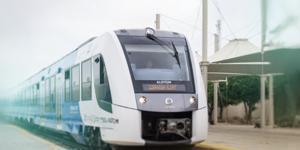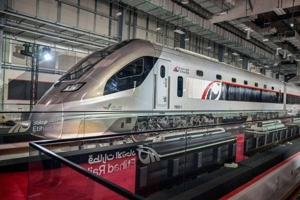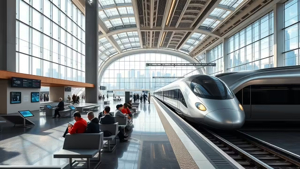
Post by : Shivani
India, Saudi Arabia, and the United Arab Emirates are rapidly advancing bullet train and high-speed rail projects to enhance connectivity, boost economic growth, and provide sustainable transportation solutions. With urbanization increasing and air travel reaching capacity limits, high-speed rail has emerged as a strategic alternative, offering faster, greener, and more reliable travel across major corridors.
These ambitious projects also reflect the commitment of governments to modernize transport infrastructure, promote tourism, and create regional economic hubs, while drawing on international expertise in rail technology.

High-speed rail reduces travel times drastically, linking cities and regions efficiently. For countries like India, Saudi Arabia, and the UAE, these systems enable rapid economic integration, improve trade logistics, and open up regional corridors for business, tourism, and employment. Bullet trains act as economic catalysts, increasing property values along the route and stimulating regional development.
Modern bullet train systems are designed with sustainability in mind. By offering an energy-efficient alternative to cars and short-haul flights, they significantly reduce carbon emissions. Advanced technologies like electric-powered trains, modern signaling systems, and energy-efficient stations ensure that bullet trains contribute to the global green transport agenda.

India’s flagship Mumbai–Ahmedabad corridor is expected to be the country’s first bullet train system. Using technology from Japan’s Shinkansen, it promises speeds up to 320 km/h, cutting the travel time between Mumbai and Ahmedabad from 8 hours to just 3 hours. This corridor is projected to transform regional mobility and attract significant economic activity along its path.
The Indian government has partnered with Japan for funding, technical support, and operational expertise. This collaboration ensures that India benefits from proven high-speed rail technology while building domestic capabilities for future rail networks.
Despite progress, India faces challenges including land acquisition, high project costs, and administrative hurdles. Public expectations are high, with passengers anticipating world-class speed, safety, and comfort. Addressing these challenges is crucial for the success and expansion of India’s high-speed rail program.
Under Vision 2030, Saudi Arabia aims to diversify its economy and modernize infrastructure. High-speed rail plays a central role in connecting key cities like Riyadh, Jeddah, and Medina while promoting tourism and economic growth in a sustainable manner.
The existing Haramain High-Speed Rail connecting Mecca and Medina provides a strong operational foundation. It demonstrates the Kingdom’s technical capabilities and serves as a model for future corridors capable of bullet train speeds.
Saudi Arabia plans to expand high-speed rail networks with international collaborations, drawing on Japanese, Chinese, and European rail expertise. These projects aim to create a comprehensive and efficient transport network across the country and potentially link with neighboring Gulf states.
The UAE’s Etihad Rail network, originally designed for freight, is being evaluated for high-speed passenger services. Potential integration of bullet trains could dramatically reduce travel times between key cities such as Abu Dhabi and Dubai while connecting with Saudi Arabia in the long term.
Cross-border high-speed rail corridors linking the UAE to Saudi Arabia and other GCC countries are under discussion. These links would facilitate trade, tourism, and labor mobility while harmonizing rail standards across nations.
UAE’s smart city initiatives complement the high-speed rail vision. Advanced ticketing systems, biometric boarding, and futuristic station designs will create a high-tech, passenger-centric experience, making travel more seamless and efficient.
India relies on Japanese Shinkansen technology, while Saudi Arabia and the UAE consider multiple international partners from China, Europe, and Japan to leverage expertise and innovation.
Acquiring land for tracks, stations, tunnels, and bridges remains a significant challenge. High costs and construction complexity can slow project timelines.
Cross-border collaboration, environmental compliance, and social acceptance are critical hurdles. Regulatory alignment and sustainability assessments are necessary to prevent delays.
Air travel and highways offer alternative options for passengers, making it essential for high-speed rail to balance cost, speed, and convenience to remain competitive.
Japan’s Shinkansen and Europe’s high-speed rail networks demonstrate the importance of operational reliability, punctuality, safety standards, and continuous maintenance. These lessons guide India, Saudi Arabia, and the UAE in designing systems that meet global best practices while adapting to local needs.
When will India’s first bullet train launch?
Projected mid-2020s, subject to testing and safety clearances.
Is Saudi Arabia planning more high-speed trains beyond Haramain?
Yes, multiple corridors are planned under Vision 2030.
Will UAE really adopt bullet trains?
Feasibility studies suggest integration by 2030, particularly through Etihad Rail.
How do these projects compare with Japan’s Shinkansen?
Modern technology allows faster construction and advanced features, but operational reliability is still being established.
What role do international partners play?
They provide funding, technology transfer, and operational expertise.
Which country will complete its bullet train first?
India currently leads with the Mumbai–Ahmedabad corridor, though timelines may change due to project challenges.
High-speed rail in India, Saudi Arabia, and the UAE represents transformative opportunities for economic growth, regional connectivity, and sustainable travel. While challenges such as land acquisition, funding, and cross-border coordination exist, strong governmental support, international partnerships, and technological innovation are likely to make bullet train dreams a reality over the next decade.
The next era of travel in Asia and the Middle East will not just be defined by distance, but by speed, efficiency, and the seamless integration of high-speed rail into modern cities.
#BulletTrain #MumbaiAhmedabadBulletTrain #HighSpeedRail #Infrastructure #EngineeringMarvel #IndiaInfrastructure #MakeInIndia #SustainableTransport #RailwayConstruction #MegaProject #CivilEngineering










Advances in Aerospace Technology and Commercial Aviation Recovery
Insights into breakthrough aerospace technologies and commercial aviation’s recovery amid 2025 chall

Defense Modernization and Strategic Spending Trends
Explore key trends in global defense modernization and strategic military spending shaping 2025 secu

Tens of Thousands Protest in Serbia on Anniversary of Deadly Roof Collapse
Tens of thousands in Novi Sad mark a year since a deadly station roof collapse that killed 16, prote

Canada PM Carney Apologizes to Trump Over Controversial Reagan Anti-Tariff Ad
Canadian PM Mark Carney apologized to President Trump over an Ontario anti-tariff ad quoting Reagan,

The ad that stirred a hornets nest, and made Canadian PM Carney say sorry to Trump
Canadian PM Mark Carney apologizes to US President Trump after a tariff-related ad causes diplomatic

Bengaluru-Mumbai Superfast Train Approved After 30-Year Wait
Railways approves new superfast train connecting Bengaluru and Mumbai, ending a 30-year demand, easi